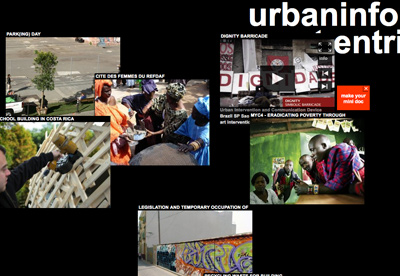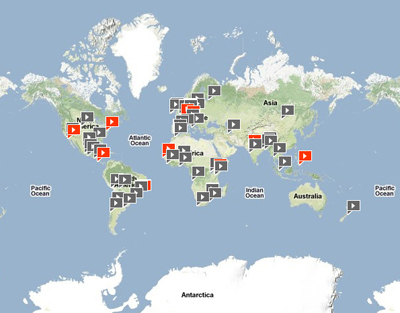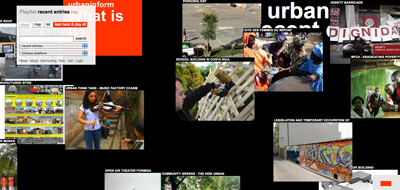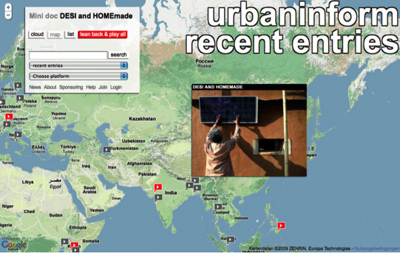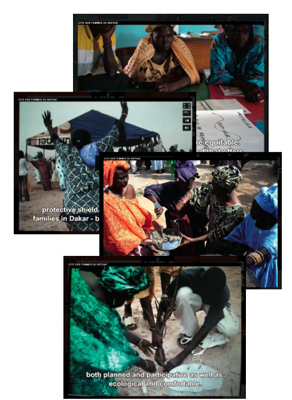urbaninform
The global tendency towards urbanization is immense: the UN estimates that in 2010 half of the world population will live in cities – 3.3 billion people and counting. One third of this global urban population lives in slum-like conditions. Mushrooming and informally built by the dwellers themselves, the lack of connection to organised, functioning infrastructure puts residents’ health and security at risk, deprives them of the right to educational systems, and leaves them to harsh labour situations.
The constant urban influx and in particular the slums issue creates big challenges to governing authorities to support activities that improve these areas, linking them and the lives of their populations with “the other city”.
In 2009 urbaninform was launched by three architects. The website is a tool for gathering architecture and urban design projects, based on self-initiatives satisfying local needs with local materials, embedded within an informal local context. These generic projects are introduced on the site by mini-documentaries. A user-friendly tool is available on the website to produce one’s own mini-doc.
The platform’s initiators also provide support for local projects through knowledge transfer and contact to a network of experts and entrepreneurs in order to develop new ways of local and global collaboration. This platform project intends to connect bottom-up with top-down processes. In July 2010 urbaninform gained NGO status.
Till now, over 100 mini-docs of diverse projects can be watched on the web-site, located on all continents. Each project is unique according to people’s needs and imaginations, their practical, material and monetary means, yet sharing the same foundation: the vision to self-determinedly shape one’s vicinity, one’s own life: putting an end to waiting.
Not all the projects are situated in informal cities. Some are also implemented in “better off” neighbourhoods or other set-ups.
All interventions and initiatives bear witness to creativity born out of necessity. Interdisciplinary collaborations consolidate possible solutions and a reclamation of public space in order to improve communal life. Re-organisation of informal settlements and strategies for micro-urban developments inspire other projects in other locations, and vice-versa; generating a huge field for an exchange of experiences.
All the projects and initiatives presented on the website ask elementary but complex questions. How can the strategy of self-management redefine good urban governance? As spatial separation accompanies social in- and exclusion, can alternative community projects be beneficial for the whole city?
text by Rayelle Niemann, 2010
screen-shots from the urbaninform web-site
RELATED WEB SITES
→ project web-site
→ Jörg Stollmann, architect
→ Olivier de Perrot, architect
→ Int.Arch.Biennale Rotterdam
→ Small Scale, Big Change: MoMA
[ 2nd May ]
[ Al Kheimah—The Tent ]
[ Al Maq’ad—The Bench ]
[ Altelefon Alkharban—Téléphone Cassé ]
[ El Ashaa’—The Banquet ]
[ El Matam El Mish Masry ]
[ Ez-zahr—The Dice ]
[ Flatlands Av. ]
[ Here I Stand ]
[ In Memory of Protest ]
[ In the Shadow of the Pyramids ]
[ Mels - A Pause For Thought ]
[ Schaffhauser Rheinufer ]
[ Shwayet mayy—Some Water ]
[ The “Made In Musina” Project ]
• urbaninform •
[ WAM _ World Agricultural Museum ]
FEATURED THEME ON CITY SHARING
by ASUNCION MOLINOS GORDO
-
This project is an instrument for common critical analysis to help understand the reasons behind Egyptians’ diminishing …
by INAS HALABI
-
The project Letters to Fritz and Paul focuses on the expeditions of the Swiss cousins, lovers and scientists, Fritz and …
by SARAH BURGER
-
The planned modern city of Brasilia attracted me since a long time. Her defined shape, location and function proceded he …
by ADRIEN GUILLET
-
Youri Telliug talks with the artist Adrien Guillet about his project Citracit
Youri Telliug - What is Citracit …
by NIGIST GOYTOM
-
In 2013 more than 45 million people have been forced to leave their homes. This amounts to the biggest number of refugees …
by SULAFA HIJAZI
-
The on going debate on Arab identity and its (cultural) representation is strongly shaped by Edward Saidʼs formative …
by ASUNCION MOLINOS GORDO
-
WAM is a site-specific work that uses the historical trope of the cabinet of curiosities to explore the introduction of …
MORE CONTRIBUTIONS BY THE FOLLOWING
